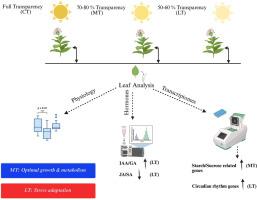通过转录组学和生理学的见解解码雪茄烟叶片发育中的遮阳效应
IF 6.8
Q1 PLANT SCIENCES
引用次数: 0
摘要
遮光或弱光是影响雪茄烟叶生长、生理和质量的关键农艺措施,但遮光反应的生理和分子机制仍不清楚。研究了QX103在全光(CT)、中度遮光(MT, 70 - 80%透光率)和重度遮光(LT, 50 - 60%透光率)3种光照条件下的生理、转录组学和农艺反应。遮荫显著提高了包皮产量(LT>MT>;CT),适度遮荫促进了最佳株高、叶展、SPAD值和光合效率。转录组分析显示,MT上调AMY、UGP2、TREH、WAXY和SPS基因,促进淀粉降解和蔗糖合成,而LT上调TPS、GN1_2_3和ISA,表明在弱光下淀粉分解代谢。昼夜节律基因(PRR5, CO, CDF1)在MT下被激活,而LT破坏时钟携带(TOC1, LHY, CRY1/2, COP1)。激素分析证实,MT提高了ICAId和TZR,支持生长,而LT增加了IAA、GA1、GA7和IPA,同时降低了SAG、DHJA和SA,表明了应激。qRT-PCR证实,MT促进了初级代谢,而LT改变了激素谱,通过改变IAA/GA和JA/SA动态介导了类似遮荫回避的反应。综上所述,适度遮荫可以平衡生长、代谢和胁迫反应,提高包皮叶品质和产量,为雪茄烟种植的精确遮荫提供了机制基础。本文章由计算机程序翻译,如有差异,请以英文原文为准。

Decoding the shading effect in cigar tobacco leaf development through transcriptomic and physiological insights
Shading or low light is a key agronomic practice affecting the growth, physiology, and quality of cigar tobacco wrapper leaves, yet the physiological and molecular mechanisms underlying shading responses remain poorly characterized. This study investigated the physiological, transcriptomic, and agronomic responses of the cultivar QX103 under three light regimes: full light (CT), moderate shading (MT, 70–80 % transmittance), and heavy shading (LT, 50–60 % transmittance). Shading significantly enhanced wrapper yield (LT>MT>CT), with moderate shading promoting optimal plant height, leaf expansion, SPAD values, and photosynthetic efficiency. Transcriptome analysis revealed distinct gene expression changes, with MT upregulating AMY, UGP2, TREH, WAXY, and SPS genes to enhance starch degradation and sucrose synthesis, whereas LT upregulated TPS, GN1_2_3, and ISA, indicating starch catabolism under low light. Circadian genes (PRR5, CO, CDF1) were activated under MT, while LT disrupted clock entrainment (TOC1, LHY, CRY1/2, COP1). Hormone profiling validated that MT enhanced ICAId and TZR, supporting growth, whereas, LT increased IAA, GA1, GA7, and IPA while reducing SAG, DHJA, and SA, indicating stress. qRT-PCR confirmed that MT promoted primary metabolism, while LT altered hormonal profiles driving a shade-avoidance-like response mediated by altered IAA/GA and JA/SA dynamics. Collectively, these results demonstrate that moderate shading balances growth, metabolism, and stress responses, improving wrapper leaf quality and yield, providing a mechanistic basis for precision shading in cigar tobacco cultivation.
求助全文
通过发布文献求助,成功后即可免费获取论文全文。
去求助
来源期刊

Plant Stress
PLANT SCIENCES-
CiteScore
5.20
自引率
8.00%
发文量
76
审稿时长
63 days
期刊介绍:
The journal Plant Stress deals with plant (or other photoautotrophs, such as algae, cyanobacteria and lichens) responses to abiotic and biotic stress factors that can result in limited growth and productivity. Such responses can be analyzed and described at a physiological, biochemical and molecular level. Experimental approaches/technologies aiming to improve growth and productivity with a potential for downstream validation under stress conditions will also be considered. Both fundamental and applied research manuscripts are welcome, provided that clear mechanistic hypotheses are made and descriptive approaches are avoided. In addition, high-quality review articles will also be considered, provided they follow a critical approach and stimulate thought for future research avenues.
Plant Stress welcomes high-quality manuscripts related (but not limited) to interactions between plants and:
Lack of water (drought) and excess (flooding),
Salinity stress,
Elevated temperature and/or low temperature (chilling and freezing),
Hypoxia and/or anoxia,
Mineral nutrient excess and/or deficiency,
Heavy metals and/or metalloids,
Plant priming (chemical, biological, physiological, nanomaterial, biostimulant) approaches for improved stress protection,
Viral, phytoplasma, bacterial and fungal plant-pathogen interactions.
The journal welcomes basic and applied research articles, as well as review articles and short communications. All submitted manuscripts will be subject to a thorough peer-reviewing process.
 求助内容:
求助内容: 应助结果提醒方式:
应助结果提醒方式:


